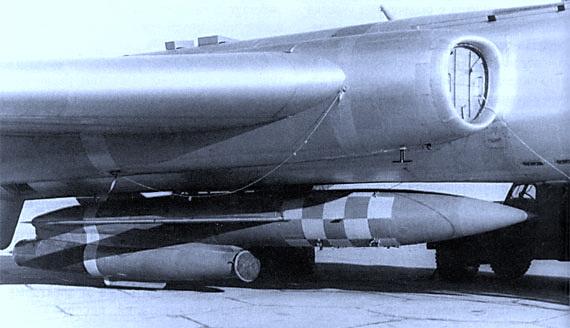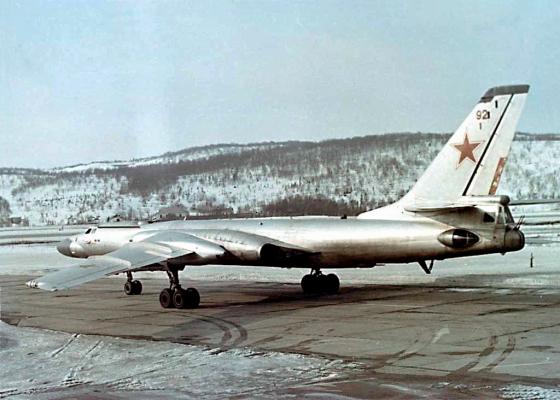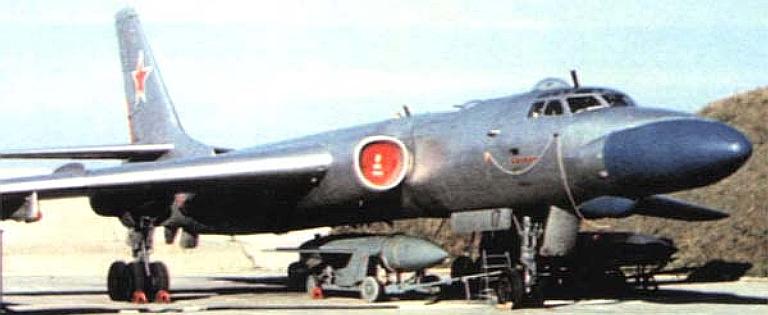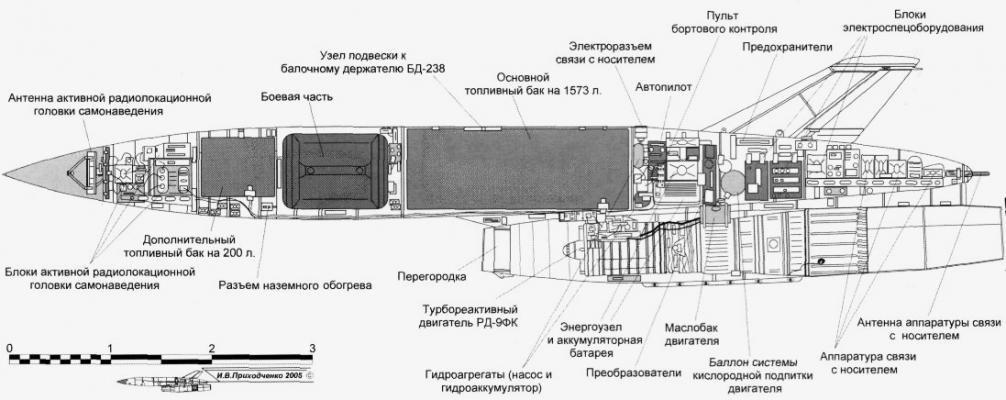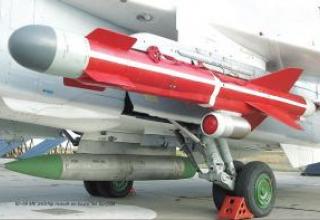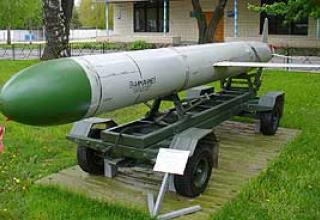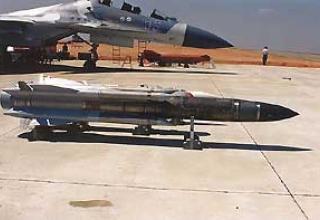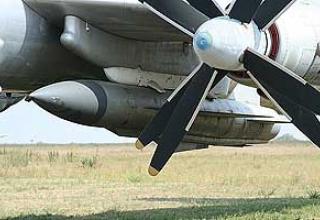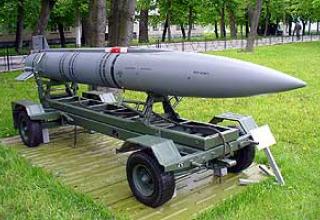Creation of the rocket system "air-to-ground" K-10 ("Comet-10") was carried out in accordance with the Government Decision of February 3, 1955 and a more detailed document dated November 16 of the same year. The leading organization was appointed Tupolev Design Bureau-256, which was to present a modified carrier aircraft Tu-16K-10 by March 1, 1957; Design Bureau-155 was the leader of the missile K-10S, whose chief designer was M.I. Gurevich. The K-10U control system, which included an aircraft radar and missile systems, was developed by KB-1 of the Ministry of Defence under the leadership of S.F. Matveevsky.
The purpose of the system was to destroy ground and surface targets within a radius of 1600-2000 km. The carrier equipment was to provide target detection from 180-250 km, and the missile was launched from a range of 200 km from an altitude of 5-11 km. In the future, it was planned to use the supersonic aircraft "105" as a carrier aircraft. (Tu-22), scheduled for production in Kazan.
The K-10S rocket was to reach a speed of 1700-2000 km/h. Its launch weight was not to exceed 4400 kg, with a combat unit weight of 1000 kg and control equipment of 350 kg. The weight of the aircraft equipment limited to 1200 kg was also specified.
In parallel, the creation of a ship version, which received the designation P-40, for the designed nuclear-powered cruiser was also specified. In accordance with the Resolutions of 17 and 25 August 1956, the cruiser of project 63 was to carry 12-16 P-40. The developers of the missile system were appointed Mikoyan Design Bureau and Research Institute-10 of the Ministry of Shipbuilding, but the ambitious project was soon abandoned in favor of more real ships and successful cruise missiles P-6 OKB-52.
For the K-10 aircraft missile system, a government decree set a deadline for execution in the 4th quarter of 1958, including the completion of joint flight tests. However, the large volume of new developments has delayed its creation, and the first Tu-16K-10 (¹ 7203805) was prepared only in November 1957, the next (¹ 7203806) - in December. By that time, the first K-10S was also presented to the OKB-155 pilot production.
The aircraft was equipped with a powerful radar with dual-channel detection and guidance equipment. Instead of the navigator's cockpit and the former "bombing" Rubidiy radar, in a voluminous nose fairing there was an antenna and target channel equipment (see photo), which provided detection and tracking of a large target from a distance of up to 400 km, in the fuselage fairing there was an antenna of the missile channel, which served for its guidance and correction during the initial phase of the flight. The station operator's workplace was equipped with a special germ cabin in the cargo bay (similar to that of the Tu-16KS). To accommodate the K-10 missile itself cargo bay was extended and equipped with a beam holder BD-238, and in the fuselage tank number 3 was dismantled. The aircraft also received more powerful power supplies necessary to ensure the operation of the radar, airborne systems and equipment of the missile. The first flight of the prototype Tu-16K-10 took place on January 4, 1958.
The first rocket K-10S arrived at the test in October 1957, but the defects and malfunctions delayed the beginning of flight tests, and the first launch was made only May 28, 1958, still in "flush mode" without the use of guidance systems. By the end of the year there were 5 more launches at a range of up to 96 km, the following year - 12, but due to numerous failures of both the equipment and the propulsion system only 6 of them were successful. Meanwhile, mass production of the Tu-16K-10 began in Kazan (the first such aircraft No 8204010 was produced in April 1958).
Joint state trials of the K-10 system began at the Research Institute of Air Forces on November 21, 1958, followed by trials from September 1959 to November 1, 960 with tactical launches on warships in the Black Sea and real - on the decommissioned tanker "Chkalov" with a displacement of 9100 tons. The 110 m long tanker simulated a cruiser-type target in terms of dimensions, and to resemble its silhouette with developed superstructures over its low-breasted hull a 13 m high metal net was stretched, estimating the holes in it as a target hit. For the tests were used two Tu-16K-10, a pair of analogues of SM-K and 34 missiles, two of which - in combat version with a standard BC. Later performed launches of another 10 K-10S, equipped with telemetry equipment that allows you to control the parameters on the trajectory (cinema-theodolite shooting the full picture did not give, and count on the safety of records after the fall of the missile did not have to). In the course of joint trials produced 184 flights of Tu-16 and 62 - analogues of SM-K. Large ships were found at a maximum range of about 400 km, corresponding to the theoretical radio horizon, the radar provided their confident capture and auto tracking.
Notable was the result achieved at one of the launches, when the K-10S, passing the target, overcame 245 km, remaining in the air 610 sec., and at the time of the fall in the tanks still had fuel reserves. However, the reliability of the system left much to be desired - due to frequent failures only half of the launches were successful, and only 10 out of 20 missiles hit the target. All five launches from the maximum distance were unsuccessful, and the claims were made not only to the quality of the system, but also to the working conditions that created problems for the crew: the operator had to work in complete isolation from the rest of the crew, in the tightness of the hermetic cabin at 40-degree temperatures, and the navigator, who was on the Tu-16K-10 behind the pilots, was deprived of normal sight (to correct the situation had to equip it with viewing windows on the fuselage).
Mistakes were distributed as follows: one missile was lost due to crew errors, the other was flown on an ice floe. Four launches were disrupted due to failures of the airborne radar, three - due to the fault of the missile's onboard equipment and in one case the engine failed.
The military considered the failures of launches due to the fault of the system to be odd and estimated the achieved probability of defeat at 0.624, which clearly did not reach the target. The developers, on the other hand, considered a number of failures to be design defects that could be eliminated in the course of modifications and suggested that they should not be taken into account when evaluating them, which gave an acceptable probability of 0.714. Later, industry representatives corrected this value to take into account the training and combat launches in 1961, presenting in the final act of the ISU "refined" value of 0.8, fully consistent with the specified government document. Lieutenant General I.I.Borzov, the chairman of the commission representing the maritime aviation, assessed the result skeptically and did not hurry to sign the act, pointing out that the achieved range of combat use of K-10S practically did not exceed KC-1, and visaed the document only in March 1961.
Meanwhile, the situation in GKAT itself has changed. For the 105. (Tu-22) was developing an improved K-10P missile with an increased range up to 300 km and a speed of about 2700-3000 km/h. The rocket was supposed to be equipped with a more powerful engine KR-5-26 thrust 4000 kgf and a triangular wing instead of a sweep. Modernization has gone so far that it was decided to create a new aircraft and missile system K-22 based on the promising aircraft Tu-22K. Therefore, the planned launch in a series of missile-carrying Tu-22K-10 (two should have been built in 1959) refused, and given the general trend to move to a purely missile systems of weapons, the prospects for the K-10 did not look good.
Rescuing the situation, June 6, 1958 Deputy Soviet of Ministers DF Ustinov and VM Ryabikov, Chairman of the SCAT PV Dementiev and Air Force Commander KA Vershinin appealed to the CPSU Central Committee with a letter, which pointed to the apparent insufficiency of the existing fleet of missile-bearing group of only 90 Tu-16KS, and the weakness of its weapons. On this basis, the production of Tu-16K-10 was maintained, and until the end of 1963 plants in Kazan and Kuibyshev produced more than 200 missile carriers.
The decision to deploy mass production of the K-10 was made back in the period of its testing - December 31, 1958. The production of a prototype series of missiles and debugging technology was carried out by the Moscow Region plant № 256, mass production was entrusted to the Tbilisi plant № 31. Taking into account the tests on the serial K-10S changed the engine gondola and air intake, to improve the dynamic parameters of the angle of deflection of ailerons increased from 12 ° to 17 ° . TsAGI also proposed to use a supersonic scoop air intake, but did not change the design due to poor development of this solution.
By a government decree of August 12, 1961 the K-10 system was adopted for service with the Navy. Taking into account the reserves of the system identified during the tests, the same decree instructed for three months to present the project K-10 increased to 300-350 km range, which was implemented by 1966 in the complex Tu-16K-10D with a missile K-10SD. The aircraft was equipped with a more powerful radar with a range of detection up to 450 km, and the upgraded missile carried an increased fuel reserve of 200 liters (due to the installation of lightweight BC).
In parallel, a low-altitude modification of the K-10SN was developed for the Tu-16K-10N complex. The carrier received an upgraded radar, and the system itself allowed for low-altitude attacks from 500-600m in stealth mode. At the stage of the second stabilized altitude, the latter was reduced from 1200 to 600m, with the missile approaching the target was only 90-150 meters above water. Another variant that combined long-range and low-altitude characteristics was the K-10SDV with an improved control and guidance system that provided the possibility of launches in a wide range of altitudes of 1500-11000 m (previously the lower boundary was 5000 m). The missile carriers for these systems were modified at the AVMF repair plant.
Since August 1959, on the basis of the K-10 was designed version of the K-14, designed for Myasischev aircraft 3MD, but due to the closure of Myasischev Design Bureau has no prospects for this topic, and the work was closed after six months by a decree of February 5, 1960. The same fate befell the K-10M target missile, designed for training the naval air defense forces.
In 1972-79, work was underway to create on the basis of the K-10SN version, equipped with a station for setting active interference. The missile that received the serial designation K-10SP and was equipped with the station "Azalia" was intended to cover the launch of combat missiles. The aircraft equipped to use the K-10SP received the designation of Tu-16K-10P, and the complex as a whole - K-10P.
The expansion of the complex's capabilities by strengthening its missile component led to the creation of the new K-26 missile system, which included the KCR-2 and КСР-5 missiles. The equipping of the Tu-16K-10 with the Q-26 system began in 1964. This complex was able to engage both sea and land targets. The complex was supposed to be assigned the cipher K-36, but as a result, the "separate" name of the K-10-26 came into use. The carrier received a reinforced wing with beam holders under the KSK-5, under the conditions of placement of which the angle of flap deflection was limited to 25 ° .
Rocket complex K-10-26 remained in service until the last years of the Soviet marine aviation. By the end of 1981 there were about 200 Tu-16K-10s in the Soviet marine aviation - about 40% of all the Tu-16s in the fleet. By the time of the collapse of the Soviet Union in the Crimea continued to serve 38 more missile carriers, another 34 vehicles were in the Northern Fleet. The final write-off of the complex K-10 occurred with the removal of Tu-16 aircraft in 1994.
According to NATO classification, the missile was designated AS-2 Kipper.
Composition:
The K-10S winged missile was an unmanned drone projectile with a boom-shaped wing and plumage, which differed in its original layout with the engine subfuselage arrangement (see projections). The latest techniques, new aircraft materials and technologies were used in its design.
Avoiding problems with the supersonic air intake device and ensuring stable operation of the engine, it was placed in a separate gondola with frontal air inlet. On the suspension, the air intake was covered by a light cocoke, which was thrown down before starting. As a power unit, taking into account the required range, the M-9FK turbojet engine was used - a short resource version of the common RD-9B, which differed from other units but was equipped with a afterburner and a starter generator necessary for power supply of on-board equipment during a rather long flight (up to 10 minutes). Its draught of 3360 kg provided the rocket with a thrust of 0.75 kg, sufficient to achieve supersonic speeds.
Equipment radio systems of the rocket was located at the ends of the fuselage: in front of a plate antenna EC-2-1 and blocks of "homing station" EC-2, in the tail of the "homing station" (ie, radio command control equipment) EC-1 and its antenna channel radio control EC1-1. The antennas of the radio altimeter EC-1-II were placed favorably in the lower part of the fuselage in front of the wing. Behind the airtight compartment with GSN equipment in the second compartment (from 5 to 15 bends) was placed a fuel tank number 1 with a protective cone and contact sensors to detonate the blast-cumulative combat unit, installed behind the tank. The 940 kg FC-10 high-explosive combined combat unit was also detonated using signals from electromechanical fuses located in front of the main fuel tank and from wing contact sensors. The main fuel tank, made of steel, formed a third compartment, located from 15 to 19 bends. The total capacity of the two tanks allowed to place 1575 liters of kerosene T-1 or TC-1 .
Behind the main fuel tank were installed units of autopilot equipment EC-3, hydraulic accumulator and piston hydraulic pump 435VM. The main on-board systems were commutation by means of a connecting box placed at the base of the keel. Ahead of it there were 27V DC power supply unit of EC-1 and EC-2 stations, PA-3000A converter and power unit providing power supply to on-board equipment. The primary energy source was the starter generator GDS-ST 12000 VTKU installed above the engine. Deviations of controls were carried out by means of steering machines of EC-4 ailerons, stabilizer and steering wheel.
The tail part of the fuselage from 29 to 32 bends formed a removable fifth compartment.
On the upper surface of the central part of the fuselage there was a suspension bungee to the carrier, kerosene and air valves, and also, in the area of the frame, a detachable connector of electric connection with the carrier RK138-4.

The projectile wing with a 1/4 chord 55° boom angle was similar to the one previously used on KS, X-20, as well as on manned I-350, MiG-19 and a number of other aircraft. At low maneuverability requirements for the K-10S was a small enough wing area - 7.0 m2. The wingspan was 4180 mm. The SrZ-7s profile thickness did not exceed 6% - the K-10S wing was one third thinner than the Mig-19 wing. Such an elegant design was realized when there was no need to place elements of the chassis in the wing due to the refusal to install fuel tanks in it. Ailerons with an area of 0.73 m2 deviated by up to ± 10° from the neutral position. In the absence of flaps ailerons were not located near the ends of the wing, and approximately in the middle of its half-span, which met the requirements of both the control channel on the roll, and the need to reduce the bending moment acting on not too rigid structure of the wing. During transportation and operation the wing arms were folded.
Horizontal plumage of 0.9 m2 with a sweep of 55 ° 52' at a swing of 1800 mm could deflect by 10 ° down and 20 ° up. The 0.915 m2 vertical plumage with a 1/4 chord 56°30' boom included a 0.26 m2 steering wheel which tilted 10° to the right and 10° to the left. The vertical and horizontal plumbers were made in the NACA-M profile with a relative thickness of 6%.
In gruzootseke Tu-16K-10 was placed beam holder BD-238 with a mechanism for cleaning and release of the rocket, which allowed to transport the K-10S in a semi-flooded position to reduce resistance in flight, and before starting to move it to the starting position, dropping down to 550mm. An additional 500 kg of kerosene tank for fueling the rocket's fuel system in flight was also suspended here, which provided engine start, heating and output under the carrier. After the launch, the holder was removed and the compartment was closed with profiled casements, when the rocket was on the suspension folded inside.
The product used a number of new technologies, different from the previous purely "aircraft". The stabilizer and keel were made of solid panels cast from magnesium alloy MV-5 in earth molds. Fuselage power frames were cast in the same way. The glider design also used dural D16T, AMG-6 for making tanks, cast alloy AL-8 and stainless steel 12X2NVFA in the power and joint units. A number of problems caused the manufacture of the bow fairing - a large-size product more than a meter in size, which at supersonic loads and high mechanical strength should have the necessary radio transparency, affecting the characteristics of the CNS. Previously, such units were molded from materials with irregular structure location, which could affect the passage of radio signals. The stability of the characteristics was ensured by the special design of the fiberglass fairing and its manufacturing technology. The cone consisted of external and internal "jackets" molded by vacuum method on steel punch, the gap between which was filled with honeycombs from glass fabric. The assembled unit was placed in the furnace, where the filler was polymerized in accordance with the three-stage temperature regime. The process, developed with the participation of VIAM, did not give good results immediately - there were flaps, stratification and deformation of the fairings, but in the end, it was perfected.
The missile was guided by a combined method: according to the autonomy requirements, preference was given to the use of an active radar GOS installed on the missile, but due to the limited capabilities of onboard equipment and energy, stable capture and homing were possible from a short distance (about 15-20 km). The launch had to be accomplished from a distance of an order of magnitude larger, and the homing of the missile to the homing boundary was accomplished with the help of on-board carrier and autopilot equipment. Accordingly, the control and guidance system of K-10U included an aircraft station, as well as equipment installed on the missile, carrying out guidance in command mode on the signals of the carrier radar, and radar SAT, as well as the on-board control system, which acted as an autopilot.
Under the conditions of reliability of the rocket engine launch, it was carried out on the suspension with the conclusion of the afterburning (for which the carrier and equipped with an additional tank). After resetting the rocket (see the scheme of guidance) went in program mode with the help of autopilot, seeping down to 1000-1500 m, and then went into a horizontal flight, holding the altitude according to an aeroid altimeter. From the 70th second of the flight at a safe distance from the carrier control of K-10S was transferred to the command mode on the ray of the aircraft radar, carried out by the operator on the azimuth (then called the "remote control by the method of combination"). He controlled the position of the missile and the target on an indicator in his cabin, trying to keep them combined.
With an exit at a distance of 105 km from the target on command from the carrier rocket began to dive at an angle of 13-18 °, and when reaching a height of 2400 m - hollow decline with an angle of 3-8 °, taking a height of 800-1000 m (the second stabilized altitude). The operator continued to keep it on course. 130 seconds after the first command, when the missile was 15-20 km away from the target, it was activated by its CNS, which captured the target and performed auto-steering until the hit. The participation of the aircraft at this stage was limited to escorting the target airborne radar and monitoring the flight of the missile on the signals of its respondent, carried out by the operator at the exit of the attack. In contrast to the "Comet", the trajectory of which was almost straightforward, K-10S maneuvering in the horizontal and vertical plane (however, not to hinder the enemy's air defense, and under the conditions of the guidance stages).
Characteristics:
| К-10С | К-10СN | К-10СD | |
| Swing, m | 4,18 | ||
| Length, m | 9,75 | ||
| Wing area, sq.m. | 7,0 | ||
| Swing of horizontal plumage, m | 1,90 | ||
| Height, m | 2,27 | ||
| Hull diameter, m | 0,92 | ||
| Starting weight, kg | 4500 | 4530 | - |
| Weight BC, kg | - | 825 | - |
| Start range, km | - | 220 | 325 |
| Launch altitude, km | 5-10 | 1,5-11 | 1,5 -11 |
| Maximum speed on the trajectory, km/h | 2030 | ||
Testing:
The first launches of K-10 in marine aviation were made by North Sea crews on the Caspian Sea in July 1960. Having departed from the airfield of the 33rd Center near Nikolaev, a pair of Tu-16K-10s reached the target, and from a height of 10,000 m at a range of 175 km the crew of Colonel Myznikov made the launch. Due to a pointing error, the missile did not reach the target, having fallen into the sea at 40 km, the crew of Lieutenant Colonel Kovalev, who followed, attacked from a distance of 170 km, achieving a direct fall into the target - the tanker "Chkalov" drowned in shallow water. Within two weeks, three more attacks were carried out, one of which again failed due to operator's error, and in one missile hit the crest of the wave just 200 m from the ship.
The training and combat launches were accompanied by supervision of industry representatives - nevertheless, the system was accepted with many reservations and required prompt correction of defects. For this purpose, even a special design and technological bureau (SCTB) was organized with participation of engineers from MAP, Design Bureau, Research Institute and AUMF. The researches carried out on the basis of the 33rd Center showed the practical feasibility of target detection from 450 km by adjusting the frequencies and length of the radar pulses. It was possible to launch long-range missiles from 325 km, and the lower limit of the aircraft flight was 500-600 m. The radar antenna of the carrier carried out scanning, mechanically rotating through the azimuth of 120 °, making it possible to turn away from the target after launch and continue to provide escort. Usually, the turn-off was performed at the 100th second with a roll of 9-12°, dictated by the possibility of stabilization of the antenna. Approximation to the target, depending on the flight mode and altitude of the launch, did not exceed 140-160 km (later withdrawal from the attack at the start of K-10SD from the maximum range could be carried out at a distance of 265 km).
In one of the departures for tactical launch in 1961, the crew of Captain G.A.Zimin faced an emergency situation, when the missile released into the starting position could not be returned. Nothing good landed with a hanging missile did not promise, because with a normal landing angle of 8 °, there was a great risk of "combing" the missile on the ground. Nevertheless, the crew managed to get the plane to land successfully, and then the instructions for such a case were introduced in the pilot's instructions.
In 1960-62, the K-10 missile system was equipped with seven air regiments of all Soviet fleets: 2nd MRAD of the Black Sea, 5th MRAD of the North, 25th and 143rd MRAD of the Pacific and 57th MRAD of the Red Banner Baltic Fleet. The intensity of development and combat training of maritime aviation crews looked impressive: for the first six months of operation in 1960 there were 79 launches, the next - 126, and in 1962 - 147 (however, the reverse side was a large consumption of combat missiles, and a duplicate aircraft like "Kometa", which allows you to save money and expensive products, for the K-10 was not available).
Another shortcoming was revealed - poor preparedness of ground services for operation of complex equipment. At first, it was assigned to a special engineering and aviation service of SIS, and the issues of warehousing, engaged in repair and maintenance base. Getting rid of duplication of work, the structure was reorganized and introduced a division of responsibilities: all systems of the aircraft were serviced by IAS specialists regiment, and the full list of work on missiles was carried out by the maintenance base.
The measures taken allowed reducing the time of equipment preparation and improving the quality of work. The confirmation was the reduction of the number of unsuccessful launches due to mistakes in the preparation of the mattress - already in 1962, their number decreased by 20%. Near the aircraft were equipped with shelters, where there were refueled and equipped with missiles, pre-tested and flying in the air on "its" carrier. The procedure of suspension and preparation of K-10 was reduced to 45 minutes, and this work was fully carried out by regimental technicians and crews - preparation for the departure of two squadrons with 16 Tu-16K-10 reduced in time by half.
We managed to reduce the number of failures, although the number of complaints about the shortcomings and defects of the system remained tangible, so the reliability of the Tu-16K-10 was inferior to other, simpler complexes, primarily through the fault of the equipment. In 1961, almost half of the completed launches failed, and about a third - due to design and manufacturing flaws.
Face-to-face with Soviet missile carriers, the United NATO Fleet had to meet in September 1964 during a major exercise "Tim Work-64", covering the entire North Atlantic. More than half a dozen ships, including two aircraft carrier groups, participated. The squadron was discovered by Tu-95 reconnaissance aircraft of the Northern Fleet, after which the command of the 5th MRAD offered to organize a response exercise with the use of aviation "on real targets", showing, for example, the head of the country to the Americans "Kuzkinu mother". Command of the Navy, however, was afraid of bringing the situation to the brink of unleashing a real war, but the top leadership of the country gave the conceived "good".
By order of the Air Force Headquarters of the NF plan was adopted for implementation. In the evening of September 21, three squadrons of Tu-16K-10 strike team of Lieutenant Colonel KL Timakov, as well as scouts, designators and interference operators who were covering the missile carriers. The ship's group was found in the ocean, the planes at low altitude stealthily reached the border of the attack. The "missile strike" was launched from three directions with a distance of 160-200 km, and the enemy was helpless to repel it.
At TOF in 1964 there was a case of attack K-10S Japanese ship, which was in the restricted zone of the range. Shino-Maru" was held near Cape Tyk, where the crew of Tu-16K-10 from the 169th MRAP worked out a training task. Having refocused, the rocket went exactly on a new "target". The Japanese were lucky - the fuse was set to detonate on the trajectory to save the targets, and the explosion occurred 400 meters from the board. The wreckage damaged the superstructure and the rocket's engine broke through the ship. Among the crew were wounded, which forced the Japanese to go to the nearest Soviet port of Kholmsk for medical care and repair. The incident managed to jam, and the Japanese side believed that the ship was hit by a crashed Soviet fighter, and expressed sympathy for the lost pilot.
During the largest strategic exercise "Ocean", held in April 1970 and covering all the fleets and water areas, the North Sea Tu-16K carried out 6 rocket launches at the range, thrown into reinforcements to them 10 missile carriers with TOF April 20 attacked the target missiles near the Kola Peninsula. Nine Tu-16K-10 of the Pacific 143rd MRAD, supported by five tankers, carried out tactical attacks in the Sea of Japan, using groups of NATO and U.S. ships as targets.
The Baltfleet's Tu-16K-10 was airborne when it intercepted the mutinous SCR "Storozheva," which left the base and headed for the Strait of Irben during the October 1975 holidays. It was supposed that he wanted to go abroad, and to stop this attempt on November 8 and 9 all forces of the fleet and aviation were alerted. Rocket attack in the area with busy shipping, fortunately, did not take place - Tu-16 found the target when the ship has already been bombed and stalled cars, but they accompanied him on the way back to the base.
With the organization of the base of the Soviet fleet in the Vietnamese port of Kamran there was placed 169th gv. SAP, which, in addition to scouts, target designation and anti-submarine aircraft, at the front positions was a squadron of Tu-16K-10-26. They served there from 1982 to 1989.
Sources:
- Николай Якубович, Анатолий Артемьев. Туполев Ту-16. Дальний бомбардировщик и ракетоносец
- Марковский В., Перов К. "Авиационные крылатые ракеты" // Авиация и космонавтика. N 10 / 2005 г
- Ракетная система К-10
- Якубович Н., "Комета" взошла в зенит. // Крылья Родины. N 10 / 1995 г.
- Р.Ангельский "Сверхзвуковая красавица"
